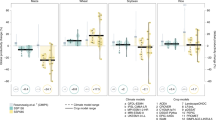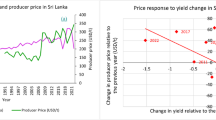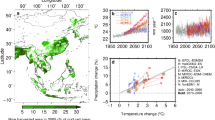Abstract
The rising carbon dioxide concentrations are expected to increase future rice yields. However, variations in the CO2 fertilization effect (CFE) between rice subspecies and the influence of concurrent global warming introduce uncertainty in future global rice yield projections. Here we conducted a meta-analysis of rising carbon dioxide field experiments and employed crop modelling to assess future global rice yields for the top 14 rice producing countries. We found a robust parabolic relationship between rice CFE and temperature, with significant variations between rice subspecies. Our projections indicate that global rice production in the 2050s is expected to increase by 50.32 million tonnes (7.6%) due to CFE compared with historical production. Because low-income countries will experience higher temperatures, the gaps (difference of Δyield) between middle-to-high-income and low-income countries are projected to widen from the 2030s to the 2090s under elevated carbon dioxide. These findings underscore the critical role of CFE and emphasize the necessity to increase investments in research and technology for rice producing systems in low-income countries.
This is a preview of subscription content, access via your institution
Access options
Access Nature and 54 other Nature Portfolio journals
Get Nature+, our best-value online-access subscription
$32.99 / 30 days
cancel any time
Subscribe to this journal
Receive 12 digital issues and online access to articles
$119.00 per year
only $9.92 per issue
Buy this article
- Purchase on SpringerLink
- Instant access to full article PDF
Prices may be subject to local taxes which are calculated during checkout




Similar content being viewed by others
Data availability
The data supporting the findings of this study are available within the article and Supplementary Information, and the national-scale rice CFE, yield and production dataset are available via figshare at https://doi.org/10.6084/m9.figshare.26028958 (ref. 51). The historical harvested area, rice yield, production and rice subspecies for the 14 top rice producing countries can be acquired from FAO (http://www.fao.org/faostat/en/) and Chinese National Bureau of Statistics. The number of rice growing seasons and rice planting and harvesting dates of the RiceAtlas database can be downloaded from https://www.nature.com/articles/sdata201774. The SPAM rice harvesting area data can be downloaded from https://www.mapspam.info/. The CMIP6 data can be downloaded from the Climate Data Store (https://cds.climate.copernicus.eu/cdsapp#!/dataset/projections-cmip6?tab=overview). Source data are provided with this paper.
Code availability
The code files can be accessed via figshare at https://doi.org/10.6084/m9.figshare.26028958 (ref. 51).
References
Chauhan, B. S., Jabran, K. & Mahajan, G. Rice Production Worldwide (Springer, 2017).
Long, S. P. Virtual special issue on food security—greater than anticipated impacts of near-term global atmospheric change on rice and wheat. Glob. Change Biol. 18, 1489–1490 (2012).
FAOSTAT (FAO, 2019); http://faostat.fao.org/default.aspx
Parry, M. L., Rosenzweig, C., Iglesias, A., Livermore, M. & Fischer, G. Effects of climate change on global food production under SRES emissions and socio-economic scenarios. Glob. Environ. Change 14, 53–67 (2004).
Rosenzweig, C. & Parry, M. L. Potential impact of climate change on world food supply. Nature 367, 133–138 (1994).
Asseng, S. et al. Uncertainty in simulating wheat yields under climate change. Nat. Clim. Change 3, 827–832 (2013).
Bassu, S. et al. How do various maize crop models vary in their responses to climate change factors? Glob. Change Biol. 20, 2301–2320 (2014).
Li, T. et al. Uncertainties in predicting rice yield by current crop models under a wide range of climatic conditions. Glob. Change Biol. 21, 1328–1341 (2015).
Rosenzweig, C. et al. Assessing agricultural risks of climate change in the 21st century in a global gridded crop model intercomparison. Proc. Natl Acad. Sci. USA 111, 3268–3273 (2014).
Yin, X. Improving ecophysiological simulation models to predict the impact of elevated atmospheric CO2 concentration on crop productivity. Ann. Bot. 112, 465–475 (2013).
Weng, J. H. & Chen, C. Y. Differences between indica and japonica rice varieties in CO2 exchange rates in response to leaf nitrogen and temperature. Photosynth. Res. 14, 171–178 (1987).
Zhu, C. et al. Biochemical and molecular characteristics of leaf photosynthesis and relative seed yield of two contrasting rice cultivars in response to elevated CO2. J. Exp. Bot. 65, 6049–6056 (2014).
Lv, C., Huang, Y., Sun, W., Yu, L. & Zhu, J. Response of rice yield and yield components to elevated [CO2]: a synthesis of updated data from FACE experiments. Eur. J. Agron. 112, 125961 (2020).
Hasegawa, T. et al. Rice cultivar responses to elevated CO2 at two free-air CO2 enrichment (FACE) sites in Japan. Funct. Plant Biol. 40, 148–159 (2013).
Zhang, G. et al. Grain growth of different rice cultivars under elevated CO2 concentrations affects yield and quality. Field Crops Res. 179, 72–80 (2015).
Lv, C. H., Huang, Y., Sun, W. J., Yu, L. F. & Zhu, J. G. Response of rice yield and yield components to elevated [CO2]: a synthesis of updated data from FACE experiments. Eur. J. Agron. 112, 125961 (2020).
Long, S. P., Ainsworth, E. A., Leakey, A. D. B., Nosberger, J. & Ort, D. R. Food for thought: lower-than-expected crop yield stimulation with rising CO2 concentrations. Science 312, 1918–1921 (2006).
Kim, H. Y. et al. Effects of free-air CO2 enrichment and nitrogen supply on the yield of temperate paddy rice crops. Field Crops Res. 83, 261–270 (2003).
Ainsworth, E. A. Rice production in a changing climate: a meta-analysis of responses to elevated carbon dioxide and elevated ozone concentration. Glob. Change Biol. 14, 1642–1650 (2008).
Seck, P. A., Diagne, A., Mohanty, S. & Wopereis, M. Crops that feed the world 7: rice. Food Secur. 4, 7–24 (2012).
Bernacchi, C. J., Singsaas, E. L., Pimentel, C., Portis, A. R. & Long, S. P. Improved temperature response functions for models of Rubisco-limited photosynthesis. Plant Cell Environ. 24, 253–259 (2001).
Moore, C. E. et al. The effect of increasing temperature on crop photosynthesis: from enzymes to ecosystems. J. Exp. Bot. 72, 2822–2844 (2021).
Chaloner, T. M., Gurr, S. J. & Bebber, D. P. Plant pathogen infection risk tracks global crop yields under climate change. Nat. Clim. Change 11, 710–715 (2021).
Lele, U., Agarwal, M., Baldwin, B. C. & Goswami, S. Food for All: International Organizations and the Transformation of Agriculture (Oxford Univ. Press, 2021).
Ainsworth, E. A. & Long, S. P. What have we learned from 15 years of free-air CO2 enrichment (FACE)? A meta-analytic review of the responses of photosynthesis, canopy. New Phytol. 165, 351–371 (2005).
Cai, C. et al. Responses of wheat and rice to factorial combinations of ambient and elevated CO2 and temperature in FACE experiments. Glob. Change Biol. 22, 856–874 (2016).
Sakai, H., Tokida, T., Usui, Y., Nakamura, H. & Hasegawa, T. Yield responses to elevated CO2 concentration among Japanese rice cultivars released since 1882. Plant Prod. Sci. 22, 352–366 (2019).
Peñuelas, J. et al. Shifting from a fertilization-dominated to a warming-dominated period. Nat. Ecol. Evol. 1, 1438–1445 (2017).
Kropff, M. J., van Laar, H. H. & Matthews, R. B. (eds) ORYZA1: An Ecophysiological Model for Irrigated Rice Production (Research Institute for Agrobiology and Soil Fertility, 1994).
Horie, T., Nakagawa, H., Centeno, H. G. S. & Kropff, M. J. in Modeling the Impact of Climate Change on Rice Production in Asia (eds Matthews R. et al.) Ch. 4 (International Rice Research Institute, 1995).
Matthews, R. B. et al. (eds) Modeling the Impact of Climate Change on Rice Production in Asia (International Rice Research Institute, 1995).
Wheeler, T. & Von Braun, J. Climate change impacts on global food security. Science 341, 508–513 (2013).
The State of Food Security and Nutrition in the World 2022 (WFP, WHO & UNICEF, 2022).
Myers, S. S. et al. Increasing CO2 threatens human nutrition. Nature 510, 139–142 (2014).
Loladze, I. Hidden shift of the ionome of plants exposed to elevated CO2 depletes minerals at the base of human nutrition. eLife 3, e02245 (2014).
Zhu, C. et al. Carbon dioxide (CO2) levels this century will alter the protein, micronutrients, and vitamin content of rice grains with potential health consequences for the poorest rice-dependent countries. Sci. Adv. 4, eaaq1012 (2018).
Fernando, N. et al. Intra-specific variation of wheat grain quality in response to elevated [CO2] at two sowing times under rain-fed and irrigation treatments. J. Cereal Sci. 59, 137–144 (2014).
Fernando, N. et al. Elevated CO2 alters grain quality of two bread wheat cultivars grown under different environmental conditions. Agric. Ecosyst. Environ. 185, 24–33 (2014).
Ebi, K. L. & Loladze, I. Elevated atmospheric CO2 concentrations and climate change will affect our food’s quality and quantity. Lancet Planet. Health 3, e283–e284 (2019).
Vermeulen, S. J., Campbell, B. M. & Ingram, J. S. I. Climate change and food systems. Annu. Rev. 37, 195–222 (2012).
Howden, S. M. et al. Adapting agriculture to climate change. Proc. Natl Acad. Sci. USA 104, 19691–19696 (2007).
Hansen, J. W. et al. Innovations in climate risk management: protecting and building rural livelihoods in a variable and changing climate. J. Semi-Arid Trop. Agric. Res. 4, 1–38 (2007).
Ziervogel, G. & Ericksen, P. Adapting to climate change to sustain food security. Wiley Interdiscip. Rev. Clim. Change 1, 525–540 (2010).
Blakeney, M. Recent developments in intellectual property and power in the private sector related to food and agriculture. Food Policy 36, S109–S113 (2011).
Alderman, H. Safety nets can help address the risks to nutrition from increasing climate variability. J. Nutr. 140, 148S–152S (2010).
Bryan, E. et al. Adaptation to climate change in Ethiopia and South Africa: options and constraints. Environ. Sci. Policy 12, 413–426 (2009).
Drag, D. W. et al. Soybean photosynthetic and biomass responses to carbon dioxide concentrations ranging from pre-industrial to the distant future. J. Exp. Bot. 71, 3690–3700 (2020).
Leakey, A. D. et al. Elevated CO2 effects on plant carbon, nitrogen, and water relations: six important lessons from FACE. J. Exp. Bot. 60, 2859–2876 (2019).
Zheng, Y. et al. Elevated CO2 concentration induces photosynthetic down-regulation with changes in leaf structure, non-structural carbohydrates and nitrogen content of soybean. BMC Plant Biol. 19, 255 (2019).
Laborte, A. G. et al. RiceAtlas, a spatial database of global rice calendars and production. Sci. Data 4, 170074 (2017).
Song, L. et al. Rising atmospheric carbon dioxide concentration increases gaps of rice yields between low and middle-to-high income countries. figshare https://doi.org/10.6084/m9.figshare.26028958 (2024).
Acknowledgements
The work was supported by grants from the National Natural Science Foundation of China (32001191 to L.S., 31870423 to C.Z., 32171591 to C.C.), the Carbon Peaking and Carbon Neutrality Special Fund for Science and Technology from Nanjing Science and Technology Bureau (20221103 to C.Z.), the Key-Area Research and Development Program of Guangdong Province, China (number 2020B0202010006 to C.Z.), the Key and General projects of Jiangsu Province (BE2018402 to C.Z.), the Doctor of Mass Entrepreneurship and Innovation in Jiangsu Province (L.S.), Key Research and Development Program of Jiangsu Province (BE2022308 to C.Z.), the Major Science and Technology Project of Ordos City (2022EEDSKJZDZX010 to C.Z.), Science Foundation of the Chinese Academy of Sciences (ISSAS2413 to C.C.) and the Spanish Government grants (TED2021-132627B-I00 to J.P.), the Fundación Ramón Areces grant (CIVP20A6621 to J.P.), and the Catalan Government grant (SGR2021-1333 to J.P.).
Author information
Authors and Affiliations
Contributions
C.Z. and L.S. conceived the study. C.Z., L.S., Y.T., J.Z., C.C. and K.N. conducted the modelling. C.Z., L.S. and Y.T. performed the investigation. L.S., Y.T. and J.Z. curated the data. L.S., Y.T., K.J.v.G., S.X.C., J.P., L.Y., S.W. and C.M. carried out the formal analyses. C.Z. supervised the study. L.S., Y.T. and C.Z. drafted the original paper. L.S., Y.T., K.J.v.G., S.X.C., J.P., J.Z., L.Y., S.W., C.C., C.M., X.Y., C.Z., Y.W., K.N. and D.W. contributed to the review and editing process.
Corresponding author
Ethics declarations
Competing interests
The authors declare no competing interests.
Peer review
Peer review information
Nature Food thanks Liyin He, Irakli Loladze and the other, anonymous, reviewer(s) for their contribution to the peer review of this work.
Additional information
Publisher’s note Springer Nature remains neutral with regard to jurisdictional claims in published maps and institutional affiliations.
Extended data
Extended Data Fig. 1 Distribution of e[CO2] experiments included in the analysis.
The circle size indicates the number of experiments at the same location. The background data indicates the distribution of the global rice-planting region using the global rice-harvest area downloaded from the Spatial Production Allocation Model: https://www.mapspam.info/.
Extended Data Fig. 2 The rice CO2 fertilization effect (CFE) as a function of different potential drivers.
a, Variations of the difference in the corrected Akaike information criterion (ΔAICc) of the most competitive regression models for the impact of rice growing season average temperature (Tair), subspecies, phosphatic fertilizer (P), potash fertilizer (K), plant density (PD) and nitrogen fertilizer (N) on CFE. b, Relative importance of potential drivers regulating the effects of CO2 increase on rice yield.
Extended Data Fig. 3 Responses of rice CFE (Carbon dioxide Fertilization Effect) to changes in [CO2].
Responses of rice CFE (Carbon dioxide Fertilization Effect) to changes in [CO2] (Δ[CO2]), based on all the data sets of FACE (Free-Air CO2 Enrichment) and OTC (Open-Top Chamber) experiments collected in this study. a, Box plots of the response of rice CFE to Δ[CO2] bins with intervals of 50 μmol mol-1 (50-100, 100-150, 150-200, 200-250, 250-300, and ≥300 μmol mol-1). Horizontal lines are medians, empty squares are means, boxes show the 25%-75% interquartile range (IQR), error bars show the full range excluding outliers defined as being more than ±1.5IQR outside the box. b, Scatter plots between average CFE across Δ[CO2] bins and Δ[CO2]. The line indicates the nonrectangular hyperbolic regression.
Extended Data Fig. 4 Box plots of CFE (Carbon dioxide Fertilization Effect) normalized to e[CO2] at 200 μmol mol-1.
Box plots of CFE (Carbon dioxide Fertilization Effect) normalized to e[CO2] at 200 μmol mol-1 for indica (a) and japonica (b) for each rice growing season average temperature (Tair) classes, including FACE (Free-Air CO2 Enrichment) and OTC (Open-Top Chamber) experiments. Each dot represents one independent experiment result. Horizontal lines are medians, empty squares are means, boxes show the 25%-75% interquartile range (IQR), error bars show the full range excluding outliers defined as being more than ±1.5IQR outside the box.
Extended Data Fig. 5 Predicted future changes in [CO2] (Δ[CO2]) compared to the average [CO2] during 2009-2018 under the SSPs (Shared Socioeconomic Pathways) 2-4.5 and 5-8.5 scenario.
The changes are averaged for each 10 or nine-year period during 2031-2099 (10-year periods for 2031-2090, and a nine-year period for 2091-2099).
Extended Data Fig. 6 Projected future mean daily air temperature (Tair) in the rice growing season for every 10- or nine-year period during 2031-2099.
Projected future mean daily air temperature (Tair) in the rice growing season for every 10- or nine-year period during 2031-2099 in the main global rice-planting regions under the “medium forcing middle-of-the-road pathway” scenario (SSP2-45). The shaded error bars represent standard deviation (SD) for Tair within the 10- or nine-year period, and the solid curve is the mean value of Tair.
Extended Data Fig. 7 Global distribution of predicted uncertainty of indica CFE (Carbon dioxide Fertilization Effect) under the “high-end forcing pathway” scenario (SSP5-85).
Global distribution of predicted uncertainty of indica CFE (Carbon dioxide Fertilization Effect) under the “high-end forcing pathway” scenario (SSP5-85) for each 10- or nine-year period during 2031-2099 (10-year periods of 2031-2040, 2041-2050, 2051-2060, 2061-2070, 2071-2080, 2081-2090, and a nine-year period of 2091-2099). The grey areas fall outside the Tair limits of this analysis.
Extended Data Fig. 8 Global distribution of predicted uncertainty of japonica CFE (Carbon dioxide Fertilization Effect) under the “high-end forcing pathway” scenario (SSP5-85).
Global distribution of predicted uncertainty of japonica CFE (Carbon dioxide Fertilization Effect) under the “high-end forcing pathway” scenario (SSP5-85) for each 10- or nine-year period during 2031-2099 (10-year period of 2031-2040, 2041-2050, 2051-2060, 2061-2070, 2071-2080, 2081-2090, and a nine-year period of 2091-2099). The grey areas fall outside the Tair limits of this analysis.
Extended Data Fig. 9 Projected future CFE (Carbon dioxide Fertilization Effect) for indica and japonica in the rice growing season.
Projected future CFE (Carbon dioxide Fertilization Effect) for indica and japonica in the rice growing season for every 10- or nine-year period during 2031-2099 in the main global rice-planting regions under the “medium forcing middle-of-the-road pathway” scenario (SSP2-45). The shaded error bars represent standard deviation (SD) of CFE within the 10- or nine-year period for indica and japonica, and the solid curves are the mean values of CFE.
Supplementary information
Supplementary Information
Supplementary Text, Figs. 1–14 and Tables 1–3, PRISMA 2020 checklist, and ROSES flow diagram for systematic reviews.
Source data
Source Data Fig. 1
Source data for Fig. 1.
Source Data Fig. 2
Source data for Fig. 2.
Source Data Fig. 3
Source data for Fig. 3.
Source Data Fig. 4
Source data for Fig. 4.
Rights and permissions
Springer Nature or its licensor (e.g. a society or other partner) holds exclusive rights to this article under a publishing agreement with the author(s) or other rightsholder(s); author self-archiving of the accepted manuscript version of this article is solely governed by the terms of such publishing agreement and applicable law.
About this article
Cite this article
Song, L., Tao, Y., van Groenigen, K.J. et al. Rising atmospheric carbon dioxide concentrations increase gaps of rice yields between low- and middle-to-high-income countries. Nat Food 5, 754–763 (2024). https://doi.org/10.1038/s43016-024-01021-x
Received:
Accepted:
Published:
Issue date:
DOI: https://doi.org/10.1038/s43016-024-01021-x
This article is cited by
-
The Effect of Climate Changes on Soil Fertility and Temperature Stress in Rice Cultivation
International Journal of Plant Production (2025)
-
Rising atmospheric carbon dioxide widens yield gaps
Nature Food (2024)



